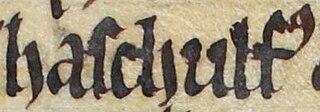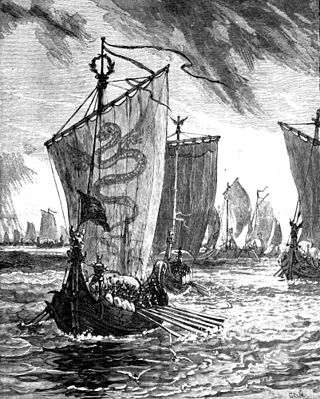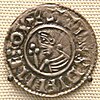Related Research Articles

Lǫgmaðr Guðrøðarson, also known as Lagmadr and Lagman of the Isle of Man, was a late eleventh-century King of the Isles, whose rise, reign, and fall from power are obscure. He was the eldest son of Guðrøðr Crovan, King of Dublin and the Isles, a Norse-Gaelic dynast who conquered and ruled the kingdoms of the Isles and Dublin, before dying in 1095. Three years after the latter's death, the Isles was conquered by Magnús Óláfsson, King of Norway, whose regime in the region lasted until his death in 1103. The chronology of Lǫgmaðr's reign is uncertain: he may have begun his reign either before Magnús' conquest, during his regime, or after his demise.

Ascall mac Ragnaill meic Torcaill, also known as Ascall Mac Torcaill, was the last Norse-Gaelic king of Dublin. He was a member of the Meic Torcaill, a Dublin family of significance since the early twelfth century.
Bjaðmunjo Mýrjartaksdóttir was a daughter of a Muirchertach Ua Briain, High King of Ireland. In 1102, whilst still a child, she was married to Sigurðr, son of Magnús Óláfsson, King of Norway. At this time, Magnús appears to have been in the process of setting up his son as king over the Earldom of Orkney, the Kingdom of the Isles, and the Kingdom of Dublin. The marriage temporarily bound Muirchertach and Magnús together as allies before the latter's death the following year. Sigurðr thereupon repudiated Bjaðmunjo, and left for Scandinavia, where he proceeded to share the Norwegian kingship with his brothers.
Ingimundr, also known as Ingimund, and Ingemund, was an eleventh-century delegate of Magnús Óláfsson, King of Norway. In the last decade of the eleventh century, Ingimundr was tasked by Magnús to take control of the Kingdom of the Isles. The realm had descended into utter chaos after the death of Guðrøðr Crovan, King of the Isles in 1095, which was followed by kin-strife amongst Guðrøðr's descendants, and the encroachment of Irish authority into the region. Ingimundr and his followers were slain in Lewis by the leading Islesmen whilst he was in the midst of securing the kingship. The following year, Magnús took matters into his own hands, and personally oversaw the conquest of the Isles himself.
Ragnall mac Gofraid was King of the Isles and likely a member of the Uí Ímair kindred. He was a son of Gofraid mac Arailt, King of the Isles. Ragnall and Gofraid flourished at a time when the Kingdom of the Isles seems to have suffered from Orcadian encroachment at the hands of Sigurðr Hlǫðvisson, Earl of Orkney. Gofraid died in 989. Although Ragnall is accorded the kingship upon his own death in 1004 or 1005, the succession after his father's death is uncertain.

Fingal mac Gofraid, and his father, Gofraid mac Sitriuc, were late eleventh-century rulers of the Kingdom of the Isles. Although one source states that Gofraid mac Sitriuc's father was named Sitriuc, there is reason to suspect that this could be an error of some sort. There is also uncertainty as to which family Gofraid mac Sitriuc belonged to. One such family, descended from Amlaíb Cúarán, King of Northumbria and Dublin, appears to have cooperated with Diarmait mac Maíl na mBó, King of Leinster. Another family, that of Echmarcach mac Ragnaill, King of Dublin and the Isles, opposed Amlaíb Cúarán's apparent descendants, and was closely connected with Diarmait's adversaries, the Uí Briain kindred.

Gofraid mac Amlaíb meic Ragnaill was a late eleventh-century King of Dublin. Although the precise identities of his father and grandfather are uncertain, Gofraid was probably a kinsman of his royal predecessor, Echmarcach mac Ragnaill, King of Dublin and the Isles. Gofraid lived in an era when control of the Kingdom of Dublin was fought over by competing Irish overlords. In 1052, for example, Echmarcach was forced from the kingdom by the Uí Chennselaig King of Leinster, Diarmait mac Maíl na mBó. When the latter died in 1072, Dublin was seized by the Uí Briain King of Munster, Toirdelbach Ua Briain, a man who either handed the Dublin kingship over to Gofraid, or at least consented to Gofraid's local rule.
Donnchad mac Domnaill Remair, also known as Donnchadh mac Domhnall Reamhair, was a late-eleventh-century ruler of the kingdoms of Leinster and Dublin. He was a son of Domnall Remar mac Máel na mBó. Donnchad was slain in 1089.
Brodar mac Torcaill, also known as Brodar Mac Turcaill, was a late twelfth century King of Dublin. He was a member of the Meic Torcaill, a substantial landholding kindred in the kingdom. His death in 1160, at the hands of the Meic Gilla Sechnaill of South Brega, is revealed by the thirteenth-century Cottonian Annals, the seventeenth-century Annals of the Four Masters, the fifteenth- to sixteenth-century Annals of Ulster, and the fourteenth-century Annals of Tigernach.

Ragnall mac Torcaill was a twelfth-century Norse-Gaelic magnate who may have been King of Dublin. He was a member of the Meic Torcaill, and may be identical to a member of this family who campaigned in Wales in 1144. Ragnall was slain in 1146, with some sources styling him king in records of his demise. He was the father of at least one son, Ascall, a man who certainly reigned as king.
Domnall Gerrlámhach, also known as Domnall Gerrlámhach Ua Briain, Domnall mac Muirchertaig, and Domnall Ua Briain, was an obscure twelfth-century Uí Briain dynast and King of Dublin. He was one of two sons of Muirchertach Ua Briain, High King of Ireland. Domnall's father appears to have installed him as King of Dublin in the late eleventh- or early twelfth century, which suggests that he was his father's successor-designate. Although Domnall won a remarkable victory in the defence of the Kingdom of Dublin in the face of an invasion from the Kingdom of Leinster in 1115, he failed to achieve the successes of his father. After his final expulsion from Dublin at the hands of Toirdelbach Ua Conchobair, King of Connacht, and the death of his father, Domnall disappears from record until his own death in 1135. He was perhaps survived by two sons.
Diarmait mac Énna meic Murchada was an early twelfth-century ruler of the kingdoms of Leinster and Dublin.
Domnall mac Taidc was the ruler of the Kingdom of the Isles, the Kingdom of Thomond, and perhaps the Kingdom of Dublin as well. His father was Tadc, son of Toirdelbach Ua Briain, King of Munster, which meant that Domnall was a member of the Meic Taidc, a branch of the Uí Briain. Domnall's mother was Mór, daughter of Echmarcach mac Ragnaill, King of Dublin and the Isles, which may have given Domnall a stake to the kingship of the Isles.
Énna Mac Murchada, or Enna Mac Murchada, also known as Énna mac Donnchada, and Énna mac Donnchada mic Murchada, was a twelfth-century ruler of Uí Chennselaig, Leinster, and Dublin. Énna was a member of the Meic Murchada, a branch of the Uí Chennselaig dynasty that came to power in Leinster in the person of his paternal great-grandfather. Énna himself gained power following the death of his cousin Diarmait mac Énna. Throughout much of his reign, Énna acknowledged the overlordship of Toirdelbach Ua Conchobair, King of Connacht, although he participated in a failed revolt against the latter in 1124 before making amends. When Énna died in 1126, Toirdelbach successfully took advantage of the resulting power vacuum.
Domnall mac Murchada, also known as Domnall mac Murchada meic Diarmata, was a leading late eleventh-century claimant to the Kingdom of Leinster, and a King of Dublin. As a son of Murchad mac Diarmata, King of Dublin and the Isles, Domnall was a grandson of Diarmait mac Máel na mBó, King of Leinster, and thus a member of the Uí Chennselaig. Domnall was also the first of the Meic Murchada, a branch of the Uí Chennselaig named after his father.
The Meic Torcaill, also known as the Meic Turcaill, the Mac Torcaill dynasty, the Mac Turcaill dynasty, and the Mac Turcaill family, were a leading Norse-Gaelic family in mediaeval Dublin. The kindred produced several eminent men and kings of Dublin before the Norman conquest of the kingdom in 1170. Afterwards the family fell from prominence, losing possession of their extensive lands in the region. In time the Meic Torcaill lost precedence to other Dublin families, such as the Harolds and Archbolds.

Mac Scelling, also known as Mac Scilling, was a prominent twelfth-century military commander engaged in conflicts throughout Ireland. He is first recorded in 1154 commanding the maritime forces of Muirchertach Mac Lochlainn, king of the Cenél nEógain, in a bloody encounter against Toirrdelbach Ua Conchobair, king of Connacht. Muirchertach's naval forces were drawn from the western peripheries of Scotland and the Isles. He next appears on record in 1173/1174, supporting the cause of Ruaidrí Ua Conchobair, king of Connacht against the English colonisation of Mide. An early modern Scottish source claims that a man of the same name was a bastard son of Somairle mac Gilla Brigte, king of the Isles. If Mac Scelling was indeed related to Somairle, this relationship could cast light on the latter's conflict with the subsequent king, Guðrøðr Óláfsson, a man who appears to have opposed Muirchertach at some point in his career. Although not termed so in contemporary sources, Mac Scelling may be regarded as an early archetype of later gallowglasses, heavily-armed Scottish mercenaries recruited by Irish rulers in centuries that followed.
Ragnall ua Ímair, also known as Ragnall mac Ragnaill, was an eleventh-century King of Waterford. He appears to have ruled as king from 1022 to 1035, the year of his death.

Gebeachan, also known as Gébennach, and Gebechán, was a tenth-century King of the Isles. He seems to have been a subordinate to Amlaíb mac Gofraid, King of Dublin, and is recorded to have fought and died at the Battle of Brunanburh in 937.
Tomrair was a ninth-century Viking active in Ireland. He is one of the first Vikings recorded by Irish sources. Tomrair is reported to have been killed at the Battle of Sciath Nechtain, a conflict in which twelve hundred Vikings were slain, battling the combined forces of Ólchobar mac Cináeda, King of Munster and Lorcán mac Cellaig, King of Leinster, in 848.
References
Primary sources
- "Annals of the Four Masters". Corpus of Electronic Texts (3 December 2013 ed.). University College Cork. 2013a. Retrieved 7 May 2019.
- "Annals of the Four Masters". Corpus of Electronic Texts (16 December 2013 ed.). University College Cork. 2013b. Retrieved 7 May 2019.
